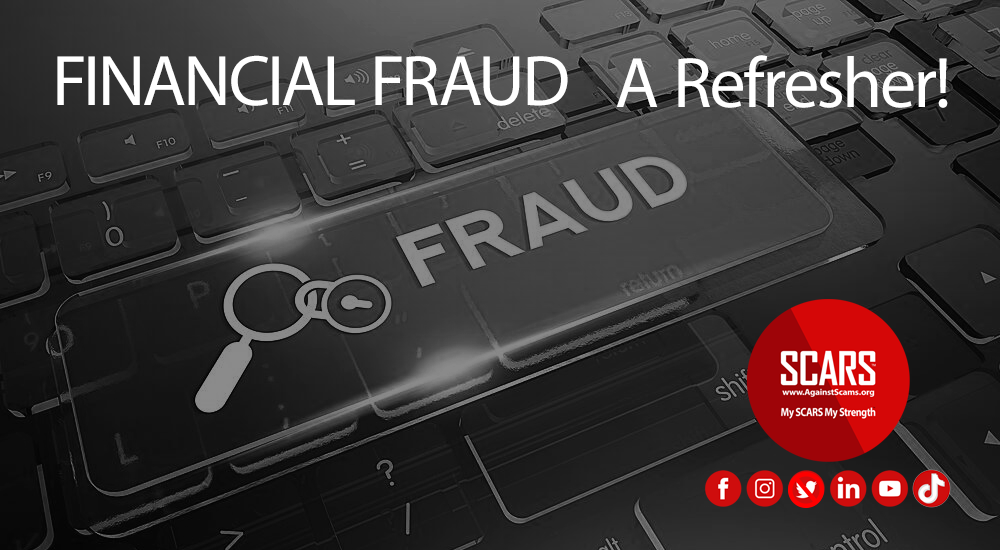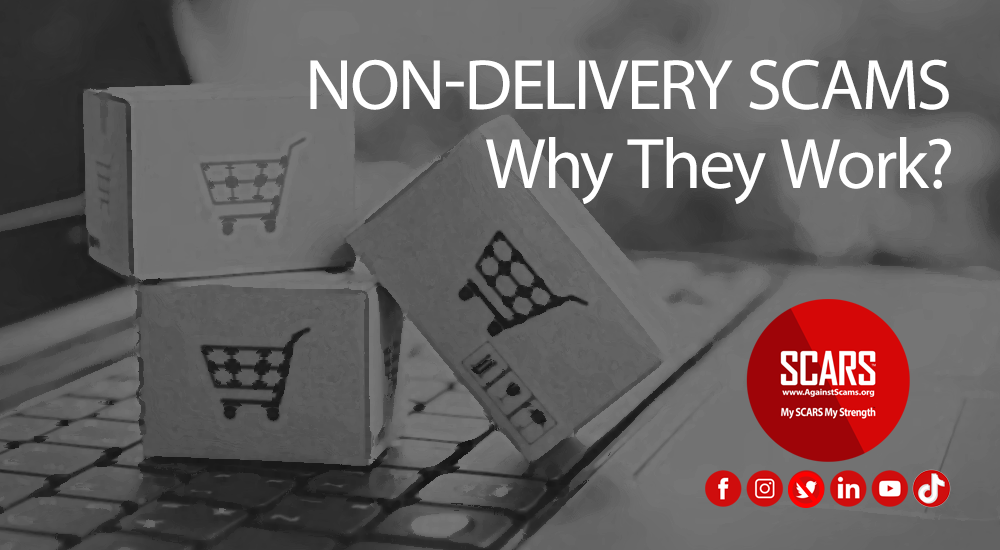The Reasons Non-Delivery & Related Scams Work
Non-Delivery / Non-Payment Fraud Works
In non-delivery fraud, criminals promise victims highly sought-after goods, accept payment, then never deliver. While the principle is simple, the fraud scheme is often sophisticated. Criminals can adapt a well-established set of methods to suit any product, whether it is medical equipment, puppies, office supplies, or electronics.
Non-Delivery / Non-Payment Scams Are Big Business!
HERE’S HOW YOU CAN AVOID BECOMING A VICTIM
What is Non-Delivery Fraud?
In non-delivery fraud, criminals promise highly sought-after goods, collect a payment, then never deliver. While the principle is simple, the fraud scheme is often sophisticated and can yield huge profits.
But it can also be the case that you are selling something, such as on eBay, and have to ship something to a buyer! Non-delivery and Non-Payment fraud go hand in hand.
Criminals are able to adapt a well-established set of methods to suit any kind of product, from masks during a pandemic to electronics or even everyday items such as paper.
The bigger the sale, the bigger the profit. Products are sold by the container load, meaning that payments can easily run into the millions.
What is Non-Payment Fraud
You are financially responsible for fraudulent purchases by your customers and/or customers’ non-payment of purchased services.
Scammers buy things from you with stolen credit cards or bogus checks. You ship the item, but you may not find out it was a fake payment for a couple of weeks, and by then you lost the physical goods.
To avoid and/or address fraudulent activity or misuse, it’s important to understand potential risks and to develop policies and practices that can reduce your exposure.
The Basics
It’s Organized Crime
Contrary to popular belief, these types of scams aren’t just carried out by lone “wheeler-dealers”. Organized crime groups have gone to great lengths to set up a sophisticated modus operandi involving websites, salespeople, intermediaries, and of course, bank accounts. Scams often involve more than one country in order to make victims feel helpless and complicate investigations.
Advertising Draws Victims In
Glossy advertisements imitate those of trustworthy businesses, attracting victims with high-quality images, brand names, and genuine reference numbers. Criminals approach potential buyers online or in person by infiltrating professional purchasing circles.
Fake websites and social media accounts almost identical to those of known businesses offer several ways to make contact with the alleged seller. Online contact forms, phone numbers, and email addresses all give the impression of a legitimate customer service center.
Everything Looks Very Official
Once contact is made, the sales exercise can begin. Prices for large orders are negotiated and validated by “superiors”. Scammers provide contracts, proforma invoices, and paperwork on official letterhead.
Careful planning goes into making the sale look as normal as possible to avoid detection.
Fraudsters then ask for an advance payment to secure the merchandise. The payments, which can go from 40% to 100% of the full order depending on the total amount, are made directly into accounts that have been opened under registered (fake) companies.
Finally, victims are given links or tracking numbers so that they can follow the shipment from the supplier to the destination.
Salespeople Manipulate Victims And Create Relationships
Alleged sellers work hard to create trust with the buyer. Whether it is flattery (“you’re my best client”), social engineering (“you’re so lucky, this product is impossible to find right now”), or lies (“we got special permission for this shipment”), the scammer will maintain contact throughout the delivery process.
The scammer will also invent as many reasons as possible to obtain extra payments along the way, such as customs fees, express delivery, insurance, etc. Contact is maintained until the victim starts to hesitate, becomes irate, or accuses the salesperson of fraud.
Then They Disappear
Once scammers feel they have been uncovered, they end all contact. Phones are cut off, emails go unanswered and websites are shut down. Victims are left in shock and ashamed, often reluctant to report the fraud to superiors and police.
Criminals, on the other hand, move on quickly and start a new fraud with a new product. If one domain is suspended or taken down, other domains are still available to attract new victims. The cycle starts again.
How To Protect Yourself From Non-Delivery Fraud
Follow these steps to protect yourself from experienced fraudsters:
- Be aware of bogus websites – criminals will often use a web address that looks almost identical to the legitimate one, e.g. ‘abc.org’ instead of ‘abc.com’;
- Verify the company/individual offering the items before making any purchases;
- Check online reviews and consumer protection groups – for example, have other customers complained about not receiving the promised items?;
- Be wary if asked to make a payment to a bank account located in a different country, as it is more difficult to liaise with entities abroad once fraud is detected;
- Keep your radar on high alert, especially if you are asked to pay unplanned fees;
Most importantly, if you believe you have been the victim of fraud, alert your bank and police immediately so the payment can be stopped and/or recalled.
According To The FBI
Non-Delivery of Merchandise
Non-delivery of merchandise is a scheme most often linked to Internet auction fraud, in which a seller on an Internet auction website accepts payment for an item yet intentionally fails to ship it. Sellers like these sometimes will relist the item and attempt to sell it again through a different username.
Non-delivery of merchandise can also be considered a form of business fraud in a number of cases. For example, some web-based international companies advertise in the U.S. for affiliate opportunities, offering individuals the chance to sell high-end electronic items, such as plasma television sets and home theater systems, at significantly reduced prices. When these items sell and the funds are forwarded to the companies from their affiliates, the items fail to ship to the individuals who sold them and thus never make it to their respective buyers.
Tips for Avoiding Non-Delivery of Merchandise:
- Make sure you are purchasing merchandise from a reputable source.
- Do your homework on the individual or company to ensure that they are legitimate.
- Obtain a physical address rather than simply a post office box and a telephone number, and call the seller to see if the telephone number is correct and working.
- Send an e-mail to the seller to make sure the e-mail address is active, and be wary of those that utilize free e-mail services where a credit card wasn’t required to open the account.
- Consider not purchasing from sellers who won’t provide you with this type of information.
- Check with the Better Business Bureau from the seller’s area.
- Check out other websites regarding this person/company.
- Don’t judge a person or company by their website; flashy websites can be set up quickly.
- Be cautious when responding to special investment offers, especially through unsolicited e-mail.
- Be cautious when dealing with individuals/companies from outside your own country.
- Inquire about returns and warranties.
- If possible, purchase items online using your credit card, because you can often dispute the charges if something goes wrong.
- Make sure the transaction is secure when you electronically send your credit card numbers.
- Consider using an alternate payment service.
PayPal Also Recommends To Reduce Non-Payment Fraud
How can you prevent fraud when shipping an order?
Here’s how you can help prevent fraud when shipping an order:
VERIFY SHIPPING ADDRESS
Go online and verify the shipping address. Look for red flags such as shipment to a freight forwarder, shipping company, P.O. Box, hotel, or a vacant property. Fraudsters often ship orders to addresses that can’t be traced back to them.
- Freight forwarder: Third-party shipping service that reships merchandise to another location (typically abroad) for a fee. To see where your package is being sent to, simply enter the shipping address into a search engine. If the search results show the name of the shipping company, be more cautious.
- Shipping companies or P.O. boxes: Fraudsters like the anonymity that shipping companies and P.O. boxes provide. However, there are also a lot of legitimate reasons for using a shipping company or a P.O. box. You just need to be more cautious, since shipping to P.O. boxes and shipping companies are typically riskier than shipping to residential addresses.
- Money / Parcel mule: Fraudsters pay people (known as money mules) to have orders shipped to their address. The money mule receives the package, then reships it to the fraudster’s address. Be careful if you have a lot of orders from different customers that are shipped to the same address.
- Vacant property: To identify vacant properties, enter the shipping address into a search engine. If the property is currently listed as for rent or for sale, it could be vacant.
SHIP WITH ONLINE TRACKING
Use a shipping service that provides online tracking to help confirm the item was delivered. Standard shipping receipts only show that an item was shipped.
- Online tracking services prove the item was delivered.
- If the total sale is for $750 or more, obtain signature confirmation to confirm your customer received their order – the nominal expense is well worth it.
- Use your discretion when shipping internationally using First Class Mail International since this shipping service is not accepted under PayPal’s Seller Protection Policy.
ORDER SHIPPING INSURANCE
Too many things can go wrong in transit. That’s why it’s important to purchase shipping insurance for items that are fragile or expensive. Shipping insurance serves two purposes:
- Insures the item in the event it is lost or damaged.
- Includes tracking and delivery information so the customer can see that the order is en route, and you will know when the package was delivered.
In case of a shipping problem, file an insurance claim with the shipping company.
You, your customer or the shipping company can report claims. Contact your shipping company for detailed instructions on how you should proceed with a claim.
- Be aware of insurance exceptions.
- Liability for loss or damage may be limited depending on the type of package, the declared value, and/or the shipping company. Talk to the shipping company to ensure proper coverage.
DELAY SHIPPING HIGH-RISK ORDERS
- Delay shipment for new orders that are expensive and in demand for 24 to 48 hours, especially when shipping internationally.
- Use caution when shipping overnight. Fraudsters will often ask for overnight shipping so that they can resell expensive merchandise as quickly as possible.
USE YOUR OWN SHIPPING SERVICE
Do not use your customer’s shipping company when mailing orders. Packages can be rerouted by the customer to other addresses after shipment, and won’t be covered by Seller Protection.
USE CARE WHEN CHOOSING OR ACTING AS A DROP SHIPPER
Since you’re responsible for delivering what the customer orders, it’s critical to choose a reputable drop shipper to help avoid losses.
- Be wary of drop-shipping companies located in high-risk countries.
- If you’re a drop shipper, have a vetting process in place for all suppliers. This should include inventory management and product guarantees (to ensure that items are in stock and you’re delivering high-quality merchandise).
Issue returns quickly and let customers know when you are out of stock/inventory
If an item is out of stock, remove the listing or update it to reflect the out-of-stock status. Provide an estimated in-stock date or clearly indicate that customers who choose an out-of-stock product are placing an advance order.
MAP IT
Example: A new customer orders a $10,000 chandelier. Here is what you can do:
Search an online map to see who and where the order is being shipped. Is the order being shipped to an expensive home, motel, or to a freight forwarder?
Use a search engine or social networking site to verify the name and shipping address. Does the name, shipping address, and billing address match?
TAGS: SCARS, Information About Scams, Anti-Scam, Scams, Scammers, Fraudsters, Cybercrime, Crybercriminals, Scam Victims, Online Fraud, Online Crime Is Real Crime, Scam Avoidance, Non-Delivery Fraud, Non-Payment Fraud, Financial Scams
PLEASE SHARE OUR ARTICLES WITH YOUR FRIENDS & FAMILY
HELP OTHERS STAY SAFE ONLINE – YOUR KNOWLEDGE CAN MAKE THE DIFFERENCE!
THE NEXT VICTIM MIGHT BE YOUR OWN FAMILY MEMBER OR BEST FRIEND!
By the SCARS™ Editorial Team
Society of Citizens Against Relationship Scams Inc.
A Worldwide Crime Victims Assistance & Crime Prevention Nonprofit Organization Headquartered In Miami Florida USA & Monterrey NL Mexico, with Partners In More Than 60 Countries
To Learn More, Volunteer, or Donate Visit: www.AgainstScams.org
Contact Us: Contact@AgainstScams.org
-/ 30 /-
What do you think about this?
Please share your thoughts in a comment below!
Article Rating
Table of Contents
- Non-Delivery / Non-Payment Fraud Works
- HERE’S HOW YOU CAN AVOID BECOMING A VICTIM
- What is Non-Delivery Fraud?
- What is Non-Payment Fraud
- It’s Organized Crime
- Advertising Draws Victims In
- Everything Looks Very Official
- Salespeople Manipulate Victims And Create Relationships
- Then They Disappear
- Follow these steps to protect yourself from experienced fraudsters:
- Most importantly, if you believe you have been the victim of fraud, alert your bank and police immediately so the payment can be stopped and/or recalled.
- Non-Delivery of Merchandise
- How can you prevent fraud when shipping an order?
- VERIFY SHIPPING ADDRESS
- SHIP WITH ONLINE TRACKING
- ORDER SHIPPING INSURANCE
- DELAY SHIPPING HIGH-RISK ORDERS
- USE YOUR OWN SHIPPING SERVICE
- USE CARE WHEN CHOOSING OR ACTING AS A DROP SHIPPER
- MAP IT
- PLEASE SHARE OUR ARTICLES WITH YOUR FRIENDS & FAMILY
- By the SCARS™ Editorial Team
Society of Citizens Against Relationship Scams Inc.
RATE THIS ARTICLE?
LEAVE A COMMENT?
Recent Comments
On Other Articles
- Nikolaus on Dating Scammers Paradise: Ivory Coast: “The Ivory Coast romance scam is still going on. It seems that local authorities don’t handle the issue effectively!” Dec 10, 02:17
- on The SCARS Institute Top 50 Celebrity Impersonation Scams – 2025: “Thank you – we will.” Dec 7, 11:41
- on The SCARS Institute Top 50 Celebrity Impersonation Scams – 2025: “You should add Sean Bean to your list of Celebrities. This one is very good, and persistent. He will be…” Dec 2, 12:07
- on How You Think & Talk About Your Scam Affects Your Recovery: “I have hung on to the scams for far too long. With the intervention of an all-merciful God, I have…” Nov 6, 22:13
- on Disengaging From A Fake Scam Relationship: “Taci, you may want to join our new support community at www.SCARScommunity.org” Nov 6, 03:01
- on Disengaging From A Fake Scam Relationship: “This particular article helped me discover the many things I did wrong the first time I was scammed. I should…” Nov 5, 22:49
- on About the SCARS RomanceScamsNOW.com Website – 24 Years Published: “It was unavailable for a few days, but it is available again. If he would be interested, he is welcome…” Nov 5, 00:59
- on About the SCARS RomanceScamsNOW.com Website – 24 Years Published: “My husband has been scammed and your classes have been helping him but now he can’t seem to access them.…” Oct 26, 14:57
- on Talia Shepard – Impersonation Victim – Stolen Photos – 2024: “Hi, I’m Patrick from Belgium and I found this site by chance, so I just got to know it, and…” Oct 17, 23:46
- on Talia Shepard – Impersonation Victim – Stolen Photos – 2024: “Hallo ik ben Patrick uit Belgie en het is in verband over PayPal. Ik heb het dit jaar spijtig genoeg…” Oct 17, 23:08
ARTICLE META
Important Information for New Scam Victims
- Please visit www.ScamVictimsSupport.org – a SCARS Website for New Scam Victims & Sextortion Victims
- Enroll in FREE SCARS Scam Survivor’s School now at www.SCARSeducation.org
- Please visit www.ScamPsychology.org – to more fully understand the psychological concepts involved in scams and scam victim recovery
If you are looking for local trauma counselors please visit counseling.AgainstScams.org or join SCARS for our counseling/therapy benefit: membership.AgainstScams.org
If you need to speak with someone now, you can dial 988 or find phone numbers for crisis hotlines all around the world here: www.opencounseling.com/suicide-hotlines
A Note About Labeling!
We often use the term ‘scam victim’ in our articles, but this is a convenience to help those searching for information in search engines like Google. It is just a convenience and has no deeper meaning. If you have come through such an experience, YOU are a Survivor! It was not your fault. You are not alone! Axios!
A Question of Trust
At the SCARS Institute, we invite you to do your own research on the topics we speak about and publish, Our team investigates the subject being discussed, especially when it comes to understanding the scam victims-survivors experience. You can do Google searches but in many cases, you will have to wade through scientific papers and studies. However, remember that biases and perspectives matter and influence the outcome. Regardless, we encourage you to explore these topics as thoroughly as you can for your own awareness.
Statement About Victim Blaming
Some of our articles discuss various aspects of victims. This is both about better understanding victims (the science of victimology) and their behaviors and psychology. This helps us to educate victims/survivors about why these crimes happened and to not blame themselves, better develop recovery programs, and to help victims avoid scams in the future. At times this may sound like blaming the victim, but it does not blame scam victims, we are simply explaining the hows and whys of the experience victims have.
These articles, about the Psychology of Scams or Victim Psychology – meaning that all humans have psychological or cognitive characteristics in common that can either be exploited or work against us – help us all to understand the unique challenges victims face before, during, and after scams, fraud, or cybercrimes. These sometimes talk about some of the vulnerabilities the scammers exploit. Victims rarely have control of them or are even aware of them, until something like a scam happens and then they can learn how their mind works and how to overcome these mechanisms.
Articles like these help victims and others understand these processes and how to help prevent them from being exploited again or to help them recover more easily by understanding their post-scam behaviors. Learn more about the Psychology of Scams at www.ScamPsychology.org
Psychology Disclaimer:
All articles about psychology and the human brain on this website are for information & education only
The information provided in this article is intended for educational and self-help purposes only and should not be construed as a substitute for professional therapy or counseling.
While any self-help techniques outlined herein may be beneficial for scam victims seeking to recover from their experience and move towards recovery, it is important to consult with a qualified mental health professional before initiating any course of action. Each individual’s experience and needs are unique, and what works for one person may not be suitable for another.
Additionally, any approach may not be appropriate for individuals with certain pre-existing mental health conditions or trauma histories. It is advisable to seek guidance from a licensed therapist or counselor who can provide personalized support, guidance, and treatment tailored to your specific needs.
If you are experiencing significant distress or emotional difficulties related to a scam or other traumatic event, please consult your doctor or mental health provider for appropriate care and support.
Also read our SCARS Institute Statement about Professional Care for Scam Victims – click here to go to our ScamsNOW.com website.



















Thank you for your comment. You may receive an email to follow up. We never share your data with marketers.